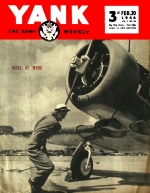Moved by the devotion and fortitude of the U.S. Army combat medics serving in the New Guinea campaign, YANK correspondent Dave Richardson wrote this short article in praise of the selfless acts performed by four outstanding medics.
1943 was truly the year that proved to have been the turning point in the war, click here to read about it...
The attached W.W. II magazine article tells the story of the hard-charging "Goums" - a detachment of French-Moroccan infantry who appeared to the American GIs as genuine curios (Wikipedia definition: "Goumier is a term used for Moroccan soldiers, who served in auxiliary units attached to the French Army, between 1908 and 1956").
"The Germans definitely don't like the Goums. As for the Italians, they're scared to death of them. In the Mateur and Bizerte sectors, where the Goums were attached to the Ninth Division, three Italian companies surrendered en masse as soon as they heard that the guys in front of them were Goums."
The attached article tells the story of the first Americans to cross the Rhine river into Germany following the capture of the Ludendorf Bridge at Remagen, Germany. "One of the most striking incidents of the first day's action on the bridge was the way German snipers opened up on their own men who had been taken prisoners. As each batch of PWs was lead across the bridge, a storm of sniper fire from the surrounding hills swept its ranks. Several were killed."
Pictured on page two is a photograph of the first American to make it across: Sgt. Alexander A. Drabik (1910 - 1993) of the 27th Armored Infantry Division. Click here to read about a popular all-girl band that performed with the USO.  |
The editors at Yank Magazine were always aware that the publication existed primarily to keep U.S. Army morale on the upward swing, but they never wished to patronize their readers by feeding them Army approved malarkey either. They knew fully that they had to give the straight dope as often as possible or they, too, would be eating k-rations at the front. There are examples of articles that seriously downplayed the disappointing outcomes of major engagements (such as Kasserine Pass and Operation Market Garden) but, by enlarge, the sugar-coating was lighter than you might think. That is why this 1944 article concerning the Battle of Tarawa is important. Yank correspondent John Bushemi (1917 - 1944) made it quite clear the U.S. Marine losses were heavy, and for that reason alone the battle was of historical significance.
Click to read about the U.S. fabric rationing during W.W. II.
A YANK staff writer Robert Bendiner (1910 - 2009), summed-up the eventful period that began with the death of President Franklin Delano Roosevelt on
April 12, and ended with the Japanese surrender on August 10, 1945. He pointed out that within that period remarkable changes had been made; not merely the deaths of Hitler, Mussolini and the collapse of Imperial Japan, but it was clear to many that the stage was being set for a new world. The foundations were in place for the creation of a "durable world security organization" and as if that wasn't enough, there was a new, hideous weapon called the "Atomic Bomb" that would cast a long shadow across the land and mark this new era as a unique period in world history.  "After a streak like that it would not be surprising if a revulsion against "big news" should set in. It may well be that people long to pick up a paper in which nothing more cosmic is reported than the city's reception of a visiting channel-swimmer, and nothing more violent than a tie-up on the Magnolia Avenue trolley line." Click here to read how British women struggled to understand American slang. The editors of Yank assembled six veteran platoon sergeants to talk about mistakes that most U.S. Army replacements make when they go into combat, and to speak seriously about which weapons and small unit tactics work best when confronting the German enemy: "The first mistake recruits make under fire" began T/Sgt. Harry R. Moore, rifle platoon sergeant from Fort Worth, Texas, "is that they freeze and bunch up. They drop to the ground and just lie there; won't even fire back. I had one man just lie there while a German came right up and shot him. He still wouldn't fight back."
to read about how the Army addressed the problem of soldiers who wouldn't pull their triggers...
|